Darlingtonia californica - the Cobra LilyCarnivorous Plants / Insectivorous Plants
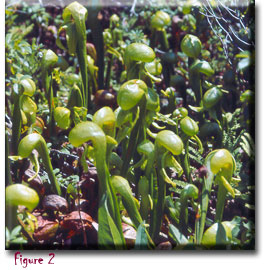 Darlintonia californica grows along stream sides and in bogs in northern California and adjacent parts of Oregon as shown in Figures 2 & 3. Although the distribution of Darlingtonia is somewhat similar to the distribution of serpentine rocks in these areas, they aren't identical at all. Darlingtonia doesn't appear restricted to the serpentine sites, but it does appear to grow well in areas rich in heavy metals. The leaf of Darlingtonia is unique: it is tubular, and contains a fluid that digests trapped insects. The upper part of the leaf, shown in Figure 1, is modified for the trapping function. The end of the leaf is hooded. There is a circular opening through which insects can fly into the hood. If you look closely you can see the opening in Figures 1, 4 and 5. So why would they do so? One reason: on the two flag-like structures, there are glands that secrete sugary nectar, such as flies and other insects like to feed on. There are more nectar glands inside the hood, so an insect tends to progress right into the hood. In a few flat boggy areas, one can see thousands of Darlingtonia plants. They prefer sunshine and don't grow well in shade. If you want to visit a large colony of Darlingtonia plants, there is one open to the public near Florence, Oregon, on the coast highway. In Figures 1, 4 & 5 we can see the hood of a leaf with its flaglike appendages. Again, notice the circular opening through which insects enter the hood. What function do you think the flaglike appendages might serve? 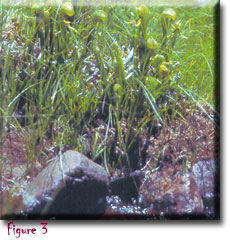 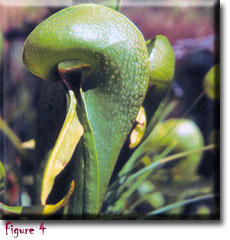 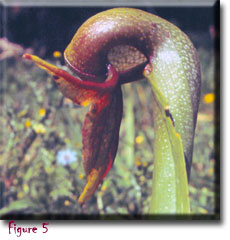 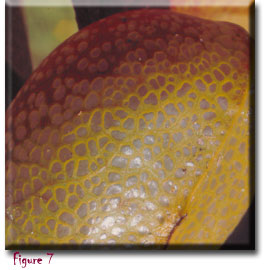 Leaves of Darlingtonia often turn reddish-purple. This is a color that tends to attract flies and may aid in leading them to the leaves. Notice also that the hood has translucent areas in it, especially near the top of the hood (Figure 5). These have a clever purpose....... 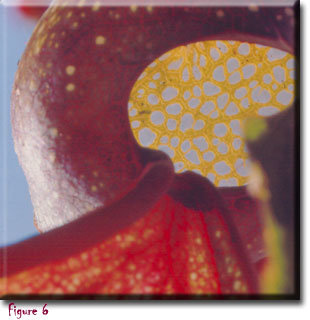 In Figure 6 we see the hood the way an entering insect sees it, and a second reason for why an insect would enter is evident. The translucent windows in the leaf tissue look skyward, so that the insect tends to fly upward thinking it is going outside of the hood..... In Figure 7 we see the windows from the outside of the hood. Note the many areas that have no chlorophyll or other pigments in the cells, they are remarkably clear. How and why do you think a plant might evolve in this manner? So why doesn't an insect just buzz around in the hood until it finds its way out through the circular opening? It is, of course, fooled by the windows. To make matters even more difficult for those who enter, the inside of the hood has a waxy surface, so that an insect landing on that surface can't get a grip and tends to fall into the tubular part of the leaf. Once in the tubular part of the leaf, shown here in the sectional view of Figure 8, it's in trouble. Sharp downwardly-pointing hairs, which here merely look like glistening areas, prevent the insect from climbing back up the tube to the hood. ...and so the insect falls into a pool of liquid at the bottom of the tube and is drowned. The pool of liquid doesn't show here because in sectioning the leaf, the liquid drained out. But in Figure 9 you can see the bodies of dead insects that have been trapped by this particular leaf. The soft parts of the insects are digested and turned into nitrogen compounds that are used by the plant. Darlingtonia, like other carnivorous plants, grow in water that is poor in nitrogen, and the soft parts of insects are rich in nitrogen and can supply that nutritional need to the plant. The hard surfaces of insects cannot be digested and remain in the leaf. 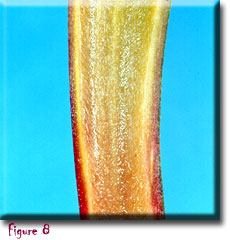 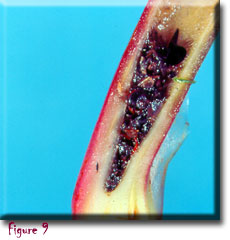 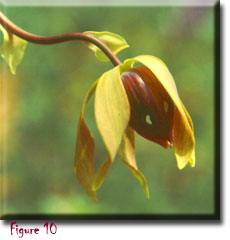 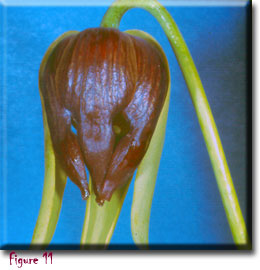 The flowers of Darlingtonia point downwards. This may keep rain out of the flowers; wet flowers usually don't get pollinated. The sepals are large and yellow-green. The petals seem almost hidden--they're dark purple as shown in Figures 10 & 11. 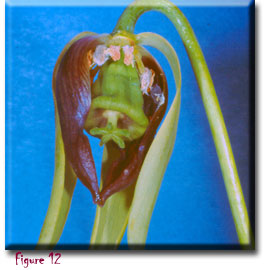 By removing some sepals, we can see the unusual nature of the petals. There are some pale translucent areas on the petals--these transmit some light to the inside of the flower, and perhaps a pollinating insect can find its way into the flower better. Also notice there are some spaces between the petals, elliptical openings through which an insect could enter....but what kind of insect? Actually, nobody knows what pollinates Darlingtonia flowers! One worker who watched the flowers didn't see any insects visiting the flowers. In various kinds of flowers, the shapes, colors, and patterns are usually closely related to the pollinators. If we remove a sepal and a petal, we can see the inside of the flower as an insect might see it. Notice one of the openings between two petals through which in insect might enter--and the translucent spots in the petals show up well in this daylight photograph. Several things about the Darlingtonia flower suggests that a beetle might visit it--but remember, nobody knows yet. 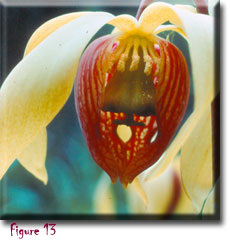 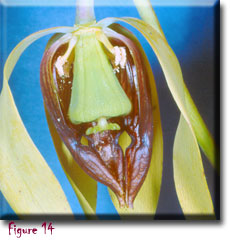 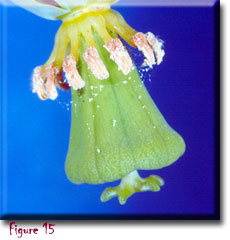 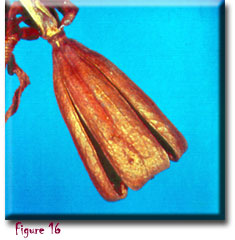 If we look at flowering plants of the world, those pollinated by beetles are frequently dark purple and green. Bees don't pay attention to those colors. Some flowers that are pollinated by beetles have traplike shapes--and the flowers of Darlingtonia fit that description. The reason why beetle-pollinated flowers have a traplike shape is that beetles don't fly in and out of flowers very efficiently--beetles tend to stay in flowers and feed on flower parts. By bumbling around inside a flower, beetles can pick up a lot of pollen or deposit it on the pollen-collecting sturfaces, the stigmas (the forklike structures in this picture). The longer a beetle stays inside a flower, the more likely it is to pollinate the flower. 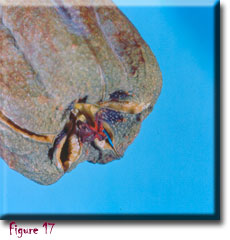 Beetle-pollinated flowers don't have nectar, whereas flowers pollinated by bees, flies, and birds do have nectar. Darlingtonia flowers have no apparent nectar, so that would fit the beetle idea. Beetles like to eat pollen--and as you can see, Darlingtonia flowers produce lots of pollen, which the flower is shedding here from its pale yellow stamens, shown above. If beetles eat the pollen, wouldn't that be bad for pollination? No, it's a compromise. Beetle-pollinated flowers produce plenty of pollen, and beetles aren't very efficient feeders, so there always seems to be plenty of pollen left over for a beetle to carry around on its surfaces, transferring that pollen to another flower. After pollination occurs, the fruit expands and turns brown when it matures. Some splits occur in the sides of the fruits, and some of the seeds might be dispersed through those splits. But more likely, the seeds escape through some openings at the end of the fruit. Notice they mouthlike openings at the end of the fruit. These close up if the fruiit gets wet during the rain, but they open ujp when the weather is dry and windy. This suggests that the seeds are dispersed by wind. The fruit of Darlingtonia is like a shaker--only a few seeds escape at a time, because the mouthlike openings are small. This benefits the plant, because dispersing seeds over a period of weeks means that the seeds will reach more places. Also, more seeds are dispersed on a windy day, because more seeds sift out through the openings. If seeds of a plant are wind-dispersed, a mechanism like this that disperses more seeds on a windier day is better, because the seeds will be carried farther, and Darlingtonia seeds could reach distant places where it could grow well. 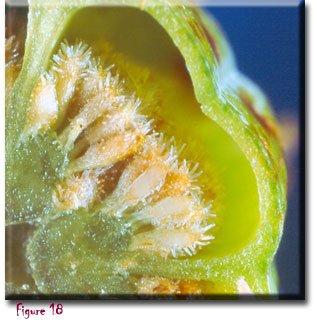 Here's what the seeds look like just before they mature. This is a cross-section of a fruit. The seeds are still attached to the central part of the fruit. When the seeds mature, they break away from the center of the fruit and gradually fall out through the openings shown in the previous picture. The places where Darlingtonia can grow--streams and bogs--are only small areas. Small seeds carried by wind would reach these small, distant areas better than would bigger seeds. 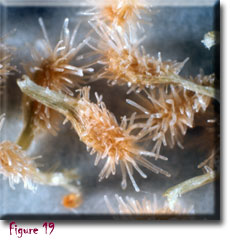 Darlingtonia seeds are small (Figure 19) --only about 3 mm long. Nobody has done research on how the seeds are dispersed--a fun project! Here's some guesses about what someone might find... The seeds sift out of the seed pods on dry windy days, and the hairs on the seeds, by increasing the surface area, permit the seeds to float farther. Possibly the stiff hairs help the seeds to get picked up by wind gusts when they fall to the ground. Streams and bogs suitable for Darlingtonia are like tiny islands in the land, so wind dispersal of seeds would be an ideal mechanism for getting them to these isolated areas. If the seeds fall onto water, they may float for a while because air bubbles get trapped among the hairs. If they are floating, the hairs may aid the seeds in catching on debris along the side of a stream or bog, and thus the seeds would reach a place suitable for their growth. |
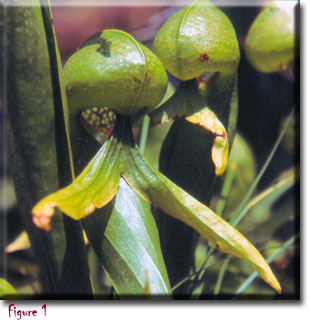 TRAP TYPE: Pitfall Trap
TRAP TYPE: Pitfall Trap



